Natural simplicity and functional design are redefining bathroom aesthetics in 2025. Scandinavian-inspired spaces continue to top renovation wishlists for homeowners seeking calm, clutter-free sanctuaries with a modern edge. This style resonates deeply for its clean lines, minimalist elegance, and ability to maximize small layouts without sacrificing warmth or practicality. Whether you’re updating a powder room or redesigning a master bath, these curated Scandinavian bathroom ideas bring clarity to your planning process. Each approach blends everyday comfort with visual harmony—perfect for those craving peace in their personal routines. Stay ahead of the trend curve with this expertly crafted guide to what truly works now.
Light Wood Accents

Visual warmth meets clean design when pale timber is integrated into bathroom surfaces. Light oak, birch, or ash instantly softens the room while maintaining the sleek, airy feel that Scandinavian interiors are known for. Whether it’s a floating vanity, framed mirror, or bench seating, lighter wood elements help break up the monotony of white surfaces without overpowering the space. Their natural grain adds depth, offering a subtle yet organic focal point.
To maintain balance, pairing light wood accents with matte finishes and white ceramics ensures cohesion. Consider vertical slatted paneling or tongue-and-groove detailing for texture without clutter. For floors, engineered wood-look tiles offer durability while mimicking the authenticity of timber. Pairing these finishes with woven baskets, linen textiles, or cane accessories creates a seamless blend of Scandinavian functionality and inviting design. Light wood also reflects daylight better, which amplifies natural illumination in windowed bathrooms.
Neutral Color Palettes

Scandi-inspired bathrooms consistently favor understated hues that support relaxation and clarity. Soft greys, warm whites, muted beiges, and gentle taupes form the backbone of this palette. These colors work together to expand small spaces visually while preventing the starkness that often comes with all-white interiors.
Layering tones from the same color family adds dimension. Consider pale stone tiles contrasted with ivory walls or off-white cabinetry grounded by sand-colored flooring. Such variations in tone allow for interest without breaking the visual calm. Neutral schemes also allow materials like wood, stone, or concrete to shine through without competition.
Textures matter just as much as tones. A matte wall finish, linen shower curtain, or brushed stone sink can offer subtle contrast without introducing new colors. When neutrals are done right, the room becomes a tranquil retreat that reflects both Nordic simplicity and enduring elegance. These hues never go out of style and can evolve easily with accessory swaps.
Minimalist Fixtures
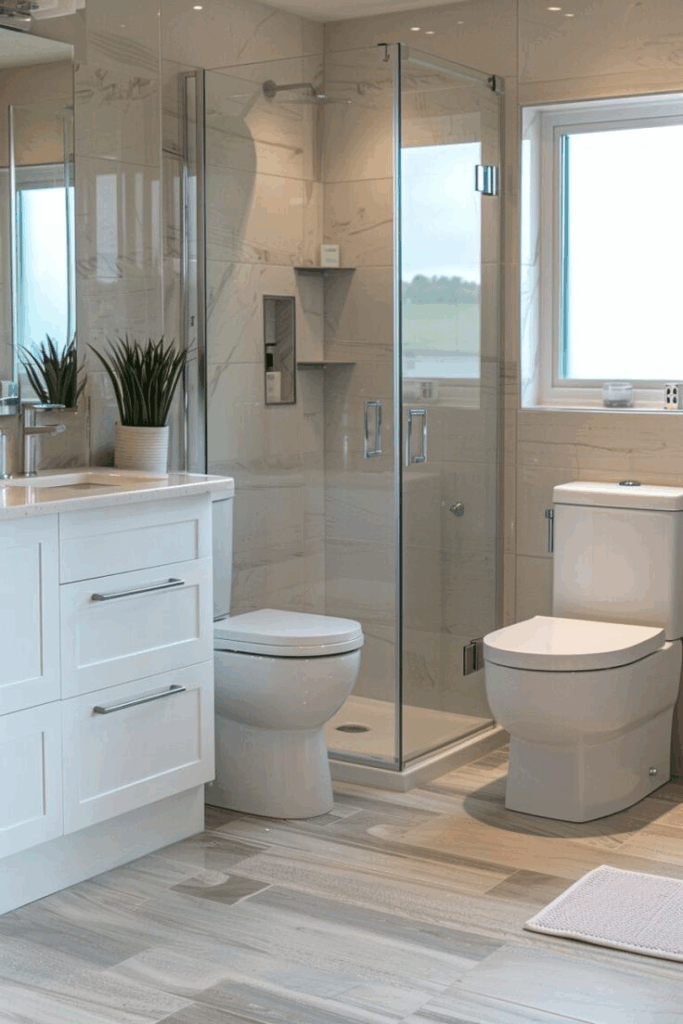
Streamlined silhouettes define the core of Scandinavian fixtures. Every piece, from the faucet to the flush plate, is chosen for both form and function. Wall-mounted taps, open-spout faucets, and slim-profile sinks provide utilitarian design without unnecessary embellishment.
The key lies in restraint. Avoid ornate or bulky hardware. Instead, look for matte or brushed finishes in steel, black, or white. Consider floating toilets, slender towel bars, and linear LED mirrors that provide brightness without clutter. Pedestal basins or wall-hung models further reduce visual bulk while improving floor accessibility.
Material choices also play a role. Opt for ceramics, solid surfaces, or metal in clean lines and rounded corners. Even in small bathrooms, minimalist fixtures enhance openness. The goal is to maintain visual space while delivering comfort and efficiency.
By keeping the design language consistent—simple, sleek, and intuitive—you cultivate an atmosphere of ease and order. It’s not about removing character; it’s about editing down to essentials that elevate everyday experiences without visual noise.
Natural Materials
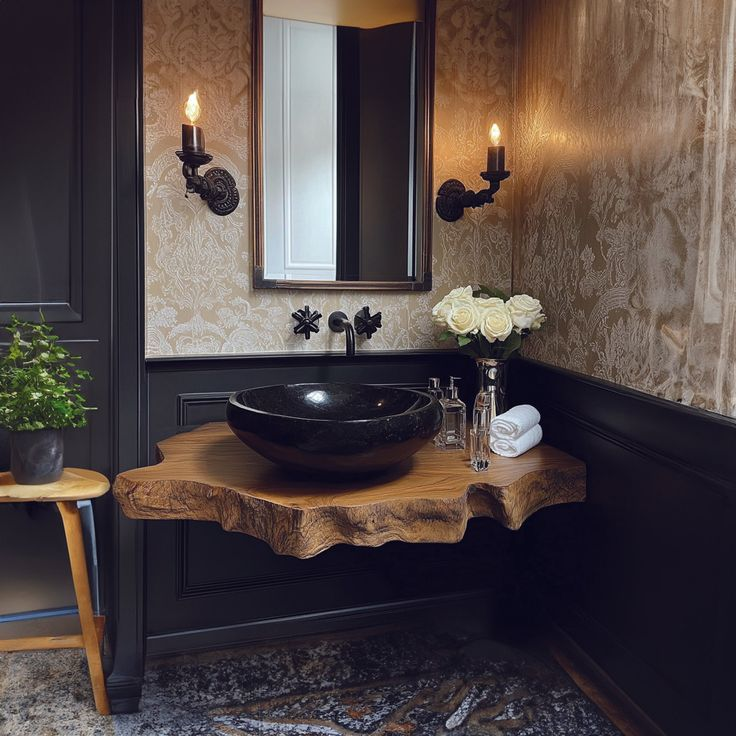
Organic surfaces are central to Nordic-inspired bathrooms. Whether it’s wood, wool, rattan, or linen, these textures balance the hard surfaces common in wet rooms. Their tactile appeal creates a sensory experience, grounding the otherwise minimalist design.
Stone is especially impactful when used for countertops, basins, or floors. Materials like marble, slate, or travertine provide subtle variations that enrich visual interest. Even concrete, when finished with care, can soften a space through natural variation and tone. Pair these with soft cotton rugs or baskets to maintain a cozy balance.
Wooden elements—treated for moisture resistance—are ideal for vanities or accent shelving. For an added Scandinavian touch, mix in tactile materials like clay pottery or woven hemp baskets. Linen towels, jute mats, and ceramic planters round out the look while keeping the palette grounded.
The focus isn’t on opulence but on authenticity. These materials age gracefully, often improving in appearance with time. By leaning into raw textures, the bathroom becomes a meditative space that mirrors the calming forces of the outdoors.
Floating Vanities
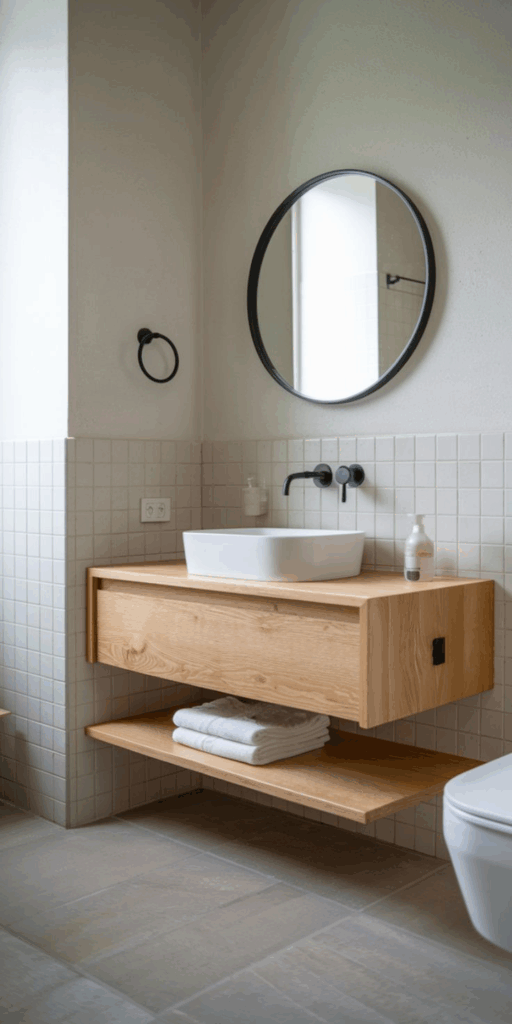
Wall-mounted vanities serve as a hallmark of Scandinavian bathrooms, combining visual lightness with everyday functionality. By removing the visual weight of floor-based cabinetry, the room instantly feels more open and breathable.
Typically constructed in pale woods or matte white finishes, floating vanities maintain a sleek profile while offering concealed storage. Soft-close drawers, integrated handles, and push-latch systems help maintain the streamlined aesthetic. They also simplify cleaning by providing open floor access beneath.
The design works particularly well in smaller bathrooms where visual clutter can quickly dominate. Matching the vanity to the wall tone creates seamless continuity, while a contrasting basin can add intentional design contrast.
Lighting underneath the vanity further emphasizes its floating effect, making the bathroom feel larger and more refined. Whether paired with a vessel sink or a minimalist integrated basin, the floating vanity delivers both style and smart use of space. Its practicality doesn’t come at the cost of beauty—precisely the balance Scandinavian interiors thrive on.
Open Shelving
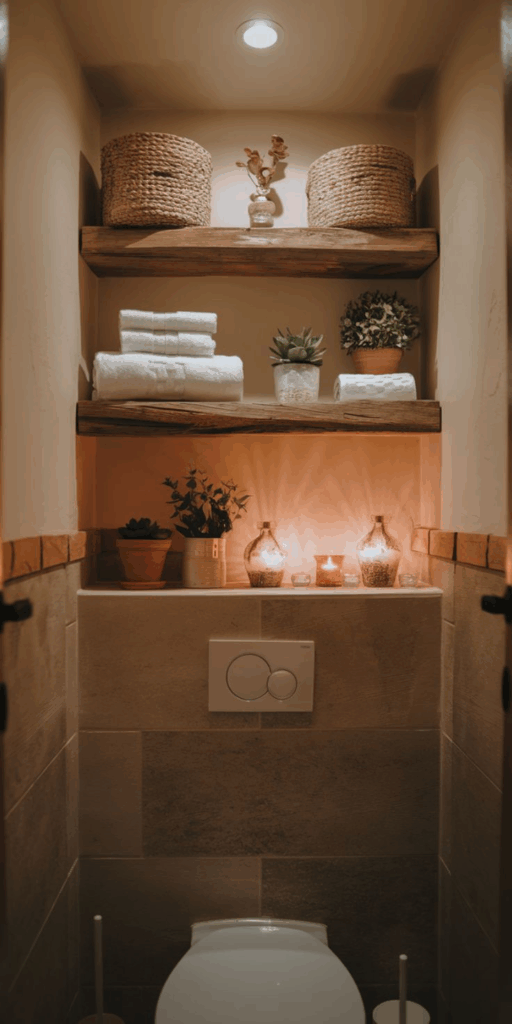
Accessible and clean-lined, open shelving introduces purposeful display into the bathroom. With careful styling, it avoids visual clutter and instead enhances function and form. Scandinavian homes prioritize utility, so every visible item should serve a purpose or contribute to the overall aesthetic.
Wooden planks mounted on simple brackets—especially in light finishes—complement neutral walls beautifully. Stack neatly folded towels, display apothecary jars, or add a single sculptural ceramic piece for quiet elegance. Items must be curated to prevent overcrowding and retain the minimalist spirit.
Use shelves as a chance to introduce small pockets of texture or greenery. Woven bins or stoneware jars provide visual contrast while staying within the Nordic theme. Keep everyday essentials within arm’s reach but hidden in baskets to reduce visual noise.
Spacing also matters. Too many shelves can dominate the wall, so limit to two or three carefully spaced units. Their functionality is undeniable, but their aesthetic value comes from restraint. With open shelving, less is truly more—every item displayed should feel intentional, not incidental.
Frameless Glass Showers
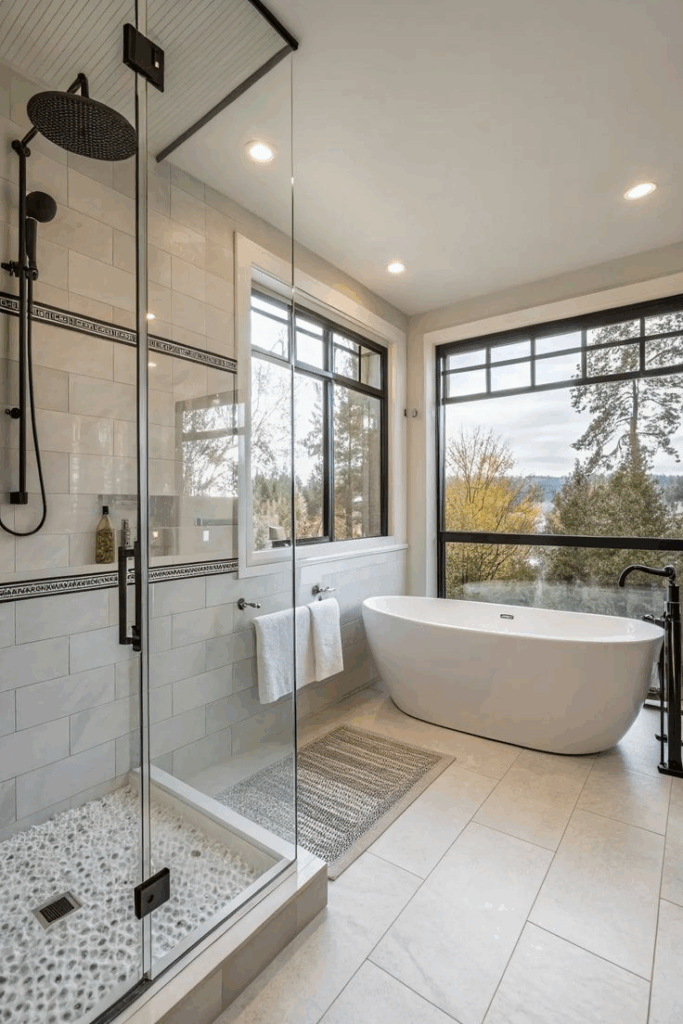
Uninterrupted sightlines are key to creating a spacious feel, especially in compact bathrooms. Frameless glass showers provide this openness while preserving a clean, modern profile. They eliminate the bulk of traditional framed enclosures and seamlessly blend with surrounding finishes.
The glass can be clear, lightly frosted, or low-iron for minimal green tint—each option influencing how the light interacts within the space. Hinged or sliding models are available, but a fixed panel is often the most minimal and elegant solution.
By forgoing hardware-heavy installations, the bathroom retains its openness. Frameless panels also pair beautifully with tiled wet-room floors, which further unify the design.
This solution isn’t just about looks—it’s practical too. Frameless showers are easier to clean, resist mildew buildup, and add to a home’s resale value due to their contemporary appeal. When designed with drainage and slope in mind, they offer the sleek functionality that’s essential in Scandinavian interiors.
Integrated Storage Solutions

Clutter disrupts the serenity that Scandinavian bathrooms aim to achieve. Integrated storage keeps essentials accessible without sacrificing aesthetic. Think recessed medicine cabinets, under-sink drawers, and built-in shower niches.
Cabinetry is typically flush-mounted and handleless, with push-latch doors and continuous grain for an uninterrupted look. Every item has its place—hidden, yet reachable. Vertical pull-outs, drawer organizers, and custom inserts help maximize even the most compact layouts.
In showers, integrated niches lined in matching tile eliminate the need for hanging caddies. Mirrors double as cabinets, and under-bench compartments offer unexpected storage for towels or accessories. Even wall cavities can be converted into hidden shelving.
The essence lies in invisibility—storage that disappears into the architecture. Function remains paramount, but not at the cost of visual serenity. The fewer items left on display, the more open and restful the bathroom feels. Scandinavian spaces excel at creating practical elegance through these smart design moves.
Matte Black Hardware

Visual contrast adds drama and definition to pale Scandi palettes, and matte black hardware accomplishes this with sophistication. From faucets to handles and towel hooks, these accents bring grounded structure without overwhelming the space.
Finish consistency is vital—mixing gloss or brushed blacks can make the space feel disjointed. Instead, unify all hardware elements in the same matte tone for cohesion. This allows each fixture to pop against light wood, white tile, or soft stone.
Opt for minimal silhouettes: thin-profile handles, sleek faucet necks, and low-profile showerheads. Matte black’s tactile, non-reflective finish adds depth without shine, aligning perfectly with the muted tone of Scandinavian design.
Use black sparingly, letting it serve as a quiet anchor. Paired with pale oak, off-white walls, or grey stone, the effect feels modern yet timeless. Matte black works as a design punctuation mark—it defines, directs, and complements without shouting.
Textured Tiles

Flat finishes can become monotonous in minimalist spaces, so surface texture is critical for visual interest. Textured tiles, from handcrafted zellige to matte-finished ceramic, enrich the room without requiring color variation.
Opt for neutral tones like off-white, soft gray, or sand. The beauty lies in irregular surfaces that catch the light differently throughout the day. Subtle ripples, grooves, or embossed patterns can all contribute to a layered aesthetic that remains calm.
Tiles with a tactile finish not only enhance sensory appeal but also improve grip on wet surfaces—ideal for safety in walk-in showers or around tubs. Their practical value is matched by their ability to break up large wall expanses.
When paired with minimal grout lines and thoughtful layout patterns like vertical stack or herringbone, the result is clean but never sterile. These tiles elevate the quiet palette by introducing movement through form. Their understated charm is a perfect fit for Scandinavian sensibility.
Skylights and Large Windows
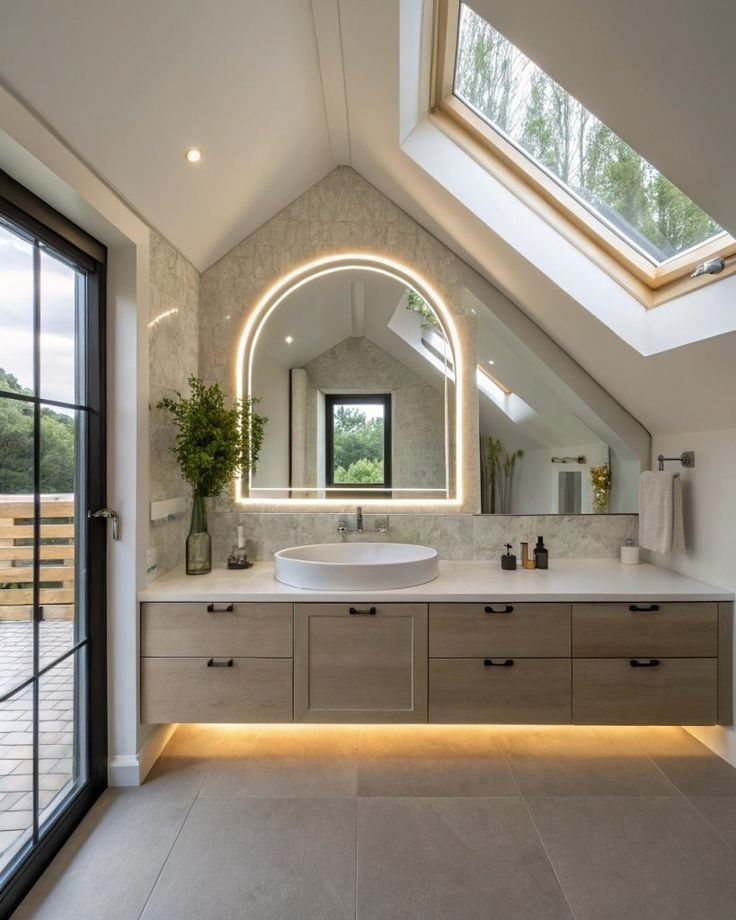
Natural light plays a defining role in Scandinavian interiors, and the bathroom is no exception. Maximizing sunlight with large windows or strategically placed skylights turns a utilitarian space into a wellness retreat. These architectural features visually enlarge the room, brighten neutral color schemes, and reduce the need for artificial lighting during daytime.
Skylights are particularly valuable in upper-floor bathrooms where privacy meets open skies. They work well above showers, bathtubs, or vanity areas. When installed with solar-controlled glazing, they maintain energy efficiency without overheating the space. Floor-to-ceiling windows, when used with frosted or privacy glass, offer stunning outdoor views without sacrificing discretion.
Framing the light with soft-toned window trims or raw wood borders enhances the Nordic vibe. Curtains, if needed, should be sheer or linen for diffused glow. By drawing on the region’s love for daylight and natural scenery, large windows or skylights transform the bathroom into a serene and luminous sanctuary.
Heated Flooring
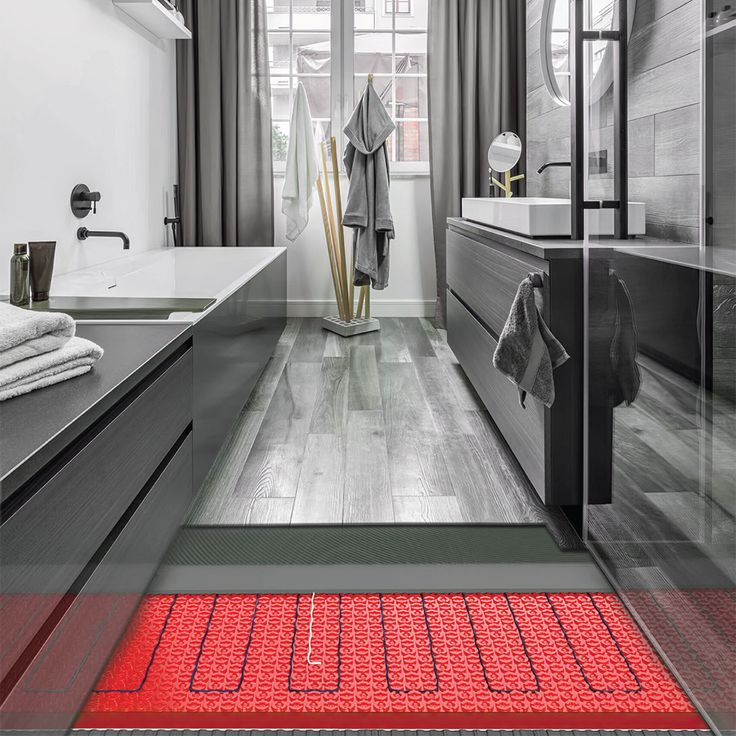
Comfort is a key principle of Scandinavian design, and radiant floor heating reflects that ethos perfectly. Especially valued in colder climates, heated flooring delivers a luxurious underfoot experience while eliminating the need for bulky radiators.
Electric or hydronic systems are both common, often paired with ceramic, porcelain, or stone tiles that distribute heat evenly. The warmth not only feels indulgent but also reduces humidity buildup, making the space more hygienic and energy-efficient.
For consistency, choose minimalist thermostats that blend into the wall or can be hidden inside cabinetry. Radiant heat also enables more freedom in layout choices since you’re not limited by radiator placement. In compact bathrooms, this opens up valuable wall and floor space.
Tactile comfort is just as important as visual aesthetics in Scandinavian homes. Heated flooring contributes to that balance, offering a hidden yet impactful upgrade that aligns with the lifestyle-driven approach of Nordic design—where every detail is thoughtfully considered.
Indoor Plants

Botanical touches breathe life into even the most pared-back Scandinavian bathrooms. Beyond aesthetics, indoor plants improve air quality and offer a refreshing contrast to the room’s hard finishes. Their organic shapes and vibrant tones stand out beautifully against neutral backdrops.
Choose species that thrive in humid, low-light conditions. Ferns, pothos, peace lilies, and ZZ plants are ideal choices. Hanging planters, wall-mounted pots, or floating shelves help integrate greenery without using precious counter space. A single large potted plant in a woven basket can also ground the room visually.
Planters should match the room’s natural tone—opt for matte ceramic, woven fiber, or light concrete finishes. For bathrooms with ample daylight, consider adding a window ledge herb garden for both style and function.
These subtle biophilic elements align with the Scandinavian mindset of fostering wellness through nature. Plants make the bathroom feel less clinical and more restorative, reinforcing the connection between minimalist design and emotional warmth.
Soft Ambient Lighting
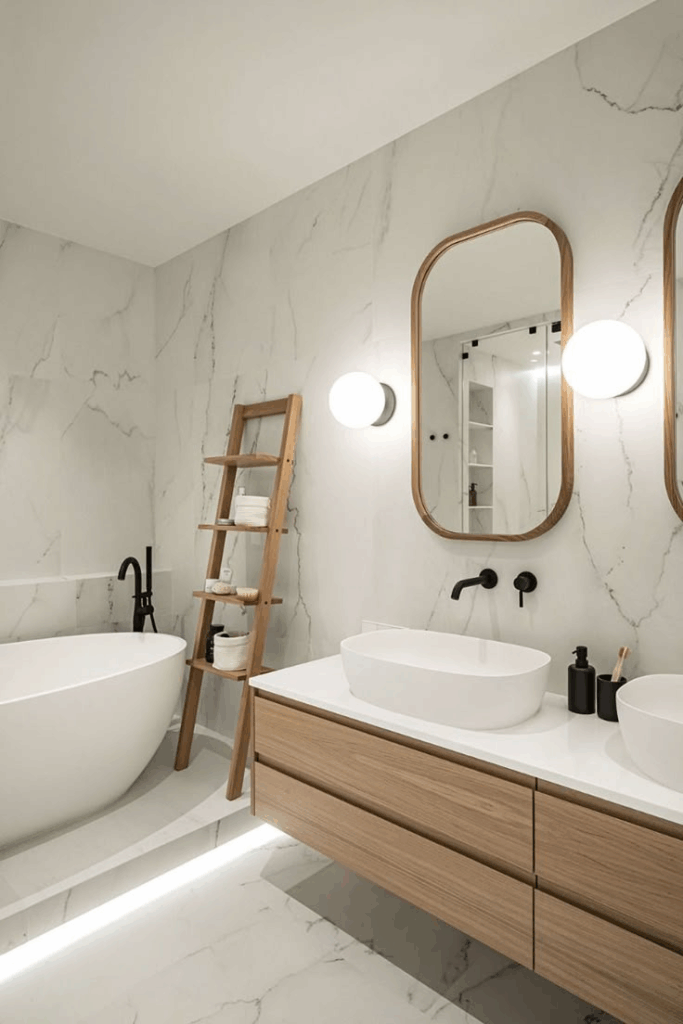
Balanced lighting is essential in achieving a calming bathroom environment. Scandinavian spaces rely on diffused, warm light to enhance the natural tones of wood and stone. Instead of harsh overhead fixtures, layered ambient lighting provides a gentle glow that flatters both the design and the user.
Wall-mounted sconces, under-vanity LED strips, and pendant lights with dimmers allow for flexibility in brightness throughout the day. Opt for frosted or opal glass shades to avoid direct glare. Natural materials like linen, rattan, or stone in the fixture design help maintain a cohesive look.
A combination of functional and decorative lighting ensures the room feels equally inviting and practical. Mirrors with integrated lighting add convenience without compromising aesthetics. Placement should highlight architectural details—like floating shelves or wall textures—while keeping shadows to a minimum.
In Scandinavian bathrooms, the light doesn’t dominate; it supports. Through intentional layering and warmth, ambient lighting creates a tranquil atmosphere that encourages relaxation and ease, aligning with the overall ethos of Nordic living.
Eco-Friendly Features
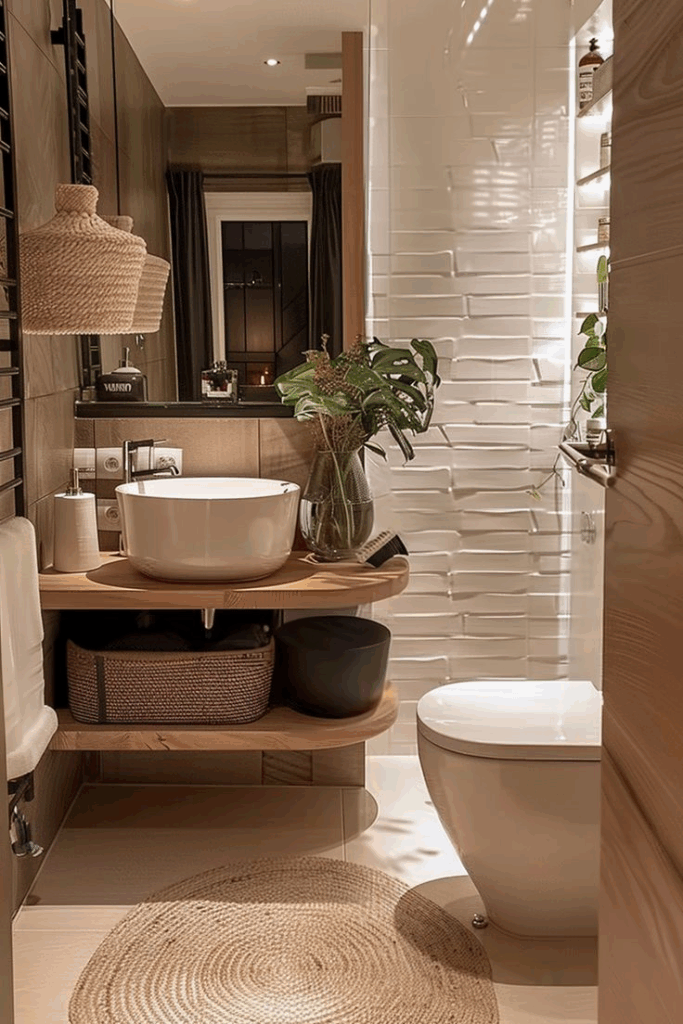
Sustainability is woven deeply into Scandinavian design philosophy, especially when it comes to the bathroom. From water-saving fixtures to renewable materials, eco-conscious decisions enhance both the environment and the overall wellness of the space.
Dual-flush toilets, low-flow showerheads, and aerated faucets help reduce water consumption without compromising performance. For surfaces, recycled glass tiles, FSC-certified wood, or bamboo alternatives provide durability with a lower environmental footprint. Natural sealants and VOC-free paints support healthier indoor air quality.
Solar tubes or energy-efficient skylights reduce dependency on artificial lighting. Even accessories, like biodegradable soap dispensers or reusable cotton storage bags, contribute to the eco-minimalist goal.
Incorporating green solutions doesn’t mean sacrificing style. Scandinavian aesthetics and sustainability align naturally, emphasizing long-lasting quality over short-term trends. The result is a bathroom that looks good, feels good, and does good—proof that functionality and environmental responsibility can coexist beautifully.
